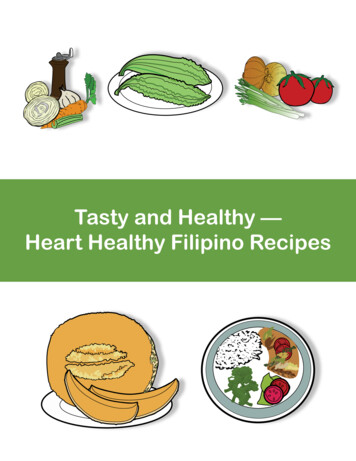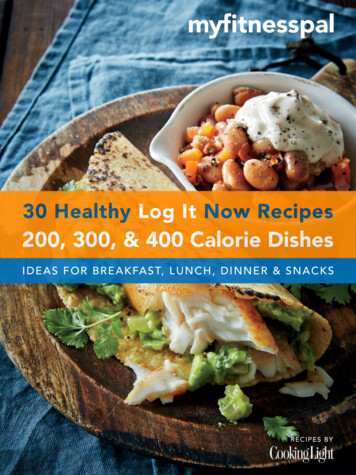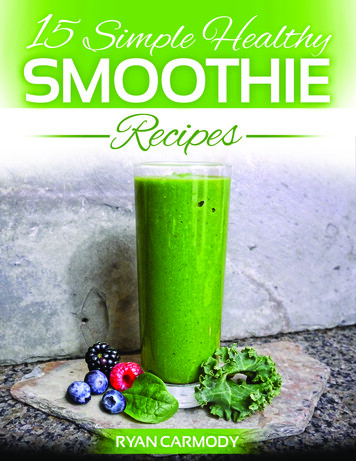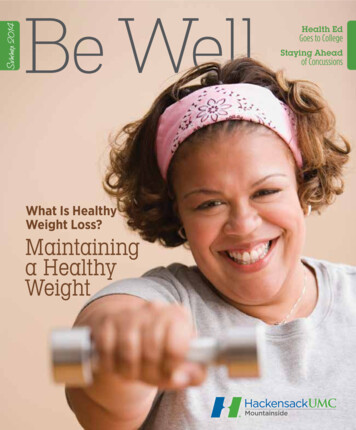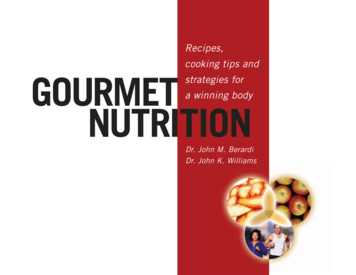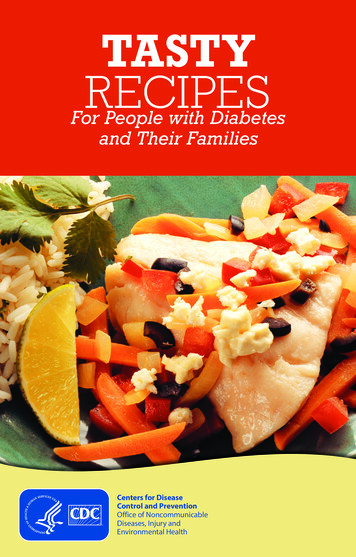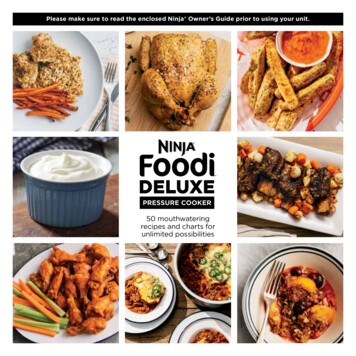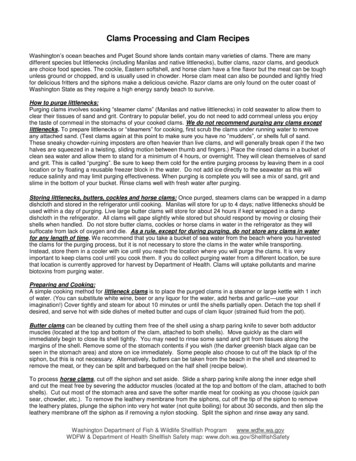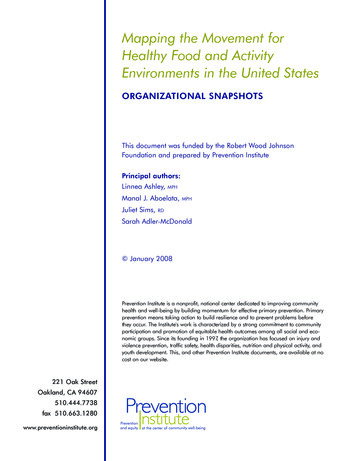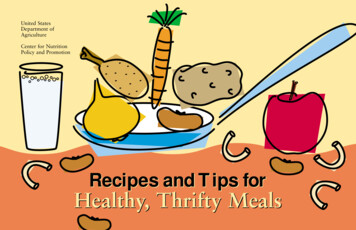
Transcription
United StatesDepartment ofAgricultureCenter for NutritionPolicy and PromotionRecipes and Tips forHealthy, Thrifty Meals
FOREWORDcontained in the Dietary Guidelines for Americansand the USDA Food Guide Pyramid. The 40 recipesare quick, easy, tasty and economical.The essence of nutrition guidance is to provide thepublic with the best information available to assistthem in making wise and nutritious food choices tosustain life and good health. As public officials in theU.S. Department of Agriculture, we are deeplyconcerned that Americans not only have enough foodbut also that the public has enough information toknow what food to purchase and how to prepare it.We hope that you will find the recipes and otherinformation provided in this book useful. At the backof the book is information on how to get morenutrition information. If you have comments orsuggestions, let us hear from you.While a healthy diet is the cornerstone to goodhealth, meeting that goal can be a challenge. That iswhy we are delighted to offer this publication to thepublic. Recipes and Tips for Healthy, Thrifty Meals ismore than a cookbook. The book provides basiccooking and food safety guidance. The menuspresented here conform to the recommendationsShirley R. WatkinsUnder SecretaryFood, Nutrition andConsumer Services1Rajen S. Anand, Ph.D.Executive DirectorCenter for NutritionPolicy and Promotion
TABLE OF CONTENTSIntroduction 4Tips for healthy, thrifty meals 5Some best buys for cost and nutrition 8Tips for healthy cooking 10Keep your family’s food safe 11Menus for 2 weeks of meals 13Recipes 18Food lists for 2 weeks of meals 69Recipe list 743
INTRODUCTIONHow can you serve healthy meals on a limitedbudget? It takes some time and planning, but youand your family can eat better for less. This bookletcan help you save money as you prepare healthymeals. It contains Tips for planning, shopping, and cooking healthymeals on a tight budget Sample menus for 2 weeks for breakfast, lunch,dinner, and snacks Recipes for healthy, thrifty meals Lists of the foods needed for each weekly menu4
TIPS FOR HEALTHY, THRIFTY MEALSgood use of leftovers. This can cut your cooking timeand food costs.WHY PLAN MEALS?To help you and your family be healthier. When youplan meals, you can make sure you include enoughfoods from each food group. Pay special attention toserving enough vegetables and fruits in family meals.TIPS FOR PLANNINGBuild the main part of your meal around rice,noodles, or other grains. Use small amounts of meat,poultry, fish, or eggs. For example, make a casserole by mixing rice,vegetables, and chicken. Or try Beef-NoodleCasserole (p. 22) or Stir-Fried Pork and Vegetableswith Rice (p. 26).To help you balance meals. When you are serving afood with a lot of fat or salt, you can plan lowfat orlow-salt foods to go with it. For example, ham ishigh in salt. If you have ham for dinner, you also canserve a salad or a vegetable that doesn’t need salt.To save money. If you plan before you go foodshopping, you will know what you have on handand what you need. Also, shopping from a list helpsyou avoid expensive “impulse” purchases.Add variety to family meals. In addition to cookingfamily favorites, try new, low-cost recipes or foodcombinations. For example, if you usually serve mashed potatoes,try Baked Crispy Potatoes (p. 49) or Potato Salad(p. 58) for a change.To save time and effort. When you plan meals, youhave foods on hand and make fewer trips to thegrocery store. Planning also helps you makecontinued5
Make meals easier to prepare by trying new waysto cook foods. For example, try using a slow cooker or crock-potto cook stews or soups. They cook foods withoutconstant watching.Plan snacks that give your family the nutrientsthey need. For example, buy fresh fruits in season like applesor peaches. Dried fruits like raisins or prunes, rawvegetables, crackers, and whole wheat bread arealso good ideas for snacks.Use planned leftovers to save both time and money. For example, prepare a Beef Pot Roast (p. 21),serve half of it, and freeze the remaining half to uselater. You also can freeze extra cooked meats andvegetables for soups or stews.TIPS FOR SHOPPINGBefore you go shopping Make a list of all the foods you need. Do thisin your kitchen so you can check what you haveon hand. Look for specials in the newspaper ads for thestores where you shop. Look for coupons for foods you plan to buy.But remember, coupons save money only if youneed the product. Also, check if other brandsare on sale, too. They may cost even less thanthe one with a coupon.Do “batch cooking” when your food budget andtime allow. For example, cook a large batch of BakedMeatballs (p. 20) or Turkey Chili (p. 39), divide itinto family-size portions, and freeze some for mealslater in the month.continued6
While you shop When your food budget allows, buy extra lowcost, nutritious foods like potatoes and frozenorange juice concentrate. These foods keep well. Compare the cost of convenience foods with thesame foods made from scratch. “Conveniencefoods” are products like fancy baked goods, frozenmeals, and vegetables with seasonings and sauces.Most of these cost more than similar foodsprepared at home. Also, you can use less fat,sugar, and salt in food you make at home. Try store brands. They usually cost less than namebrands, but they taste as good and generally havethe same nutritional value. Take time to compare fresh, frozen, and cannedfoods to see which is cheapest. Buy what’s onspecial and what’s in season. Prevent food waste. Buy only the amount that yourfamily will eat before the food spoils.Using label and shelf information Read the Nutrition Facts label on packaged foods.Compare the amount of fat, sodium, calories, andother nutrients in similar products. This can helpyou choose foods that have less fat, sodium orcalories, and more vitamins, minerals, and fiber. Use date information on packages—“sell by” and“best if used by” dates—to help you choose thefreshest foods. Look for the unit price to compare similar foods.It tells you the cost per ounce, pound, or pint, soyou’ll know which brand or size is the best buy.Most stores show the unit price on a shelf stickerjust below the product.7
SOME BEST BUYS FOR COST AND NUTRITIONBREADS AND GRAINSLook for bargains on day-old bread and bakery products.Buy regular rice, oatmeal, and grits instead of the instant andflavored types.Try whole-grain bread and brown rice to add nutrients and varietyto family meals.VEGETABLES AND SALADSLook for large bags of frozen vegetables. They may be bargains and you cancook just the amount you need, close the bag tightly, and put the rest back inthe freezer.Foods at salad bars can be costly. Some food items—lettuce, cabbage, onions,and carrots—usually cost less in the produce section of the store than at thesalad bar. But if you need only a small amount of a vegetable, buying at thesalad bar can save money if it reduces the amount you waste.FRUITSBuy fresh fruits in season, when they generally cost less.continued8
MILKNonfat dry milk is the least expensive way to buy milk. When using it as abeverage, mix it several hours ahead and refrigerate so it can get cold beforedrinking.Buy fresh milk in large containers (gallon or 1/2 gallon). These generally costless than quarts.Buy fat-free or lowfat milk to cut the amount of fat in your family’s meals.Note that children under 2 years of age should be given only whole milk.MEAT AND POULTRYLook for specials at the meat counter. Buying cuts of meat on sale can meanbig savings for you.Buy chuck or bottom round roast instead of sirloin. These cuts have less fatand cost less. They need to be covered during cooking and cooked longer tomake the meat tender.Buy whole chickens and cut them into serving size pieces yourself.DRY BEANS AND PEASUse these sometimes instead of meat, poultry, or fish. They cost less and providemany of the same nutrients. They are also lower in fat.BULK FOODSBuy bulk foods when they are available. They can be lower in price than similarfoods sold in packages. Also, you can buy just the amount you need.9
TIPS FOR HEALTHY COOKING Remove skin from poultry before cooking to lowerthe fat content. For example, try Baked ChickenNuggets (p. 34), Chicken and Vegetables (p. 36),or Oven Crispy Chicken (p. 37). Always follow food safety rules in the kitchento make sure that the food you prepare for yourfamily is safe. See the next page. Go easy on fat, sugar, and salt in preparing foods.For example, make Oven Crispy Chicken (p. 37)instead of fried chicken or make Baked Cod withCheese (p. 28) instead of fried fish. You don’t haveto leave out all the fat, sugar, or salt—just limit theamount you use. Flavor foods with herbs, spices, and other lowfatseasonings instead of using rich sauces and gravy.Look for ideas about what seasonings to use insome of the recipes in this booklet, like BakedMeatballs (p. 20), Baked Spicy Fish (p. 29), andTurkey Chili (p. 39). Make homemade desserts sometimes to savemoney and serve additional healthy foods tothe family. For example, try a fruit crisp, likePeach-Apple Crisp (p. 65), or a pudding likeRice Pudding (p. 67).10
KEEP YOUR FAMILY’S FOOD SAFE Never place cooked food on a plate or cuttingboard that previously held raw meat, chicken,turkey, or seafood.Clean—wash hands and surfaces often: Always wash hands with soap and warm runningwater before handling food. Always wash cutting boards, knives, utensils,dishes, and countertops used to cut meat withsoapy, hot water right away—before you use themfor other foods. Consider using paper towels to clean up kitchensurfaces. If you use cloth towels, dishcloths, orsponges, wash them often, and every time theyhave touched raw meat, poultry, or seafood juices.Use hot soapy water or the hot water cycle of thewashing machine.Cook—cook to proper temperatures: Use a food thermometer to make sure meats,chicken, turkey, fish, and casseroles are cooked toa safe internal temperature. Cook roasts and steaks to at least 145 F. Cook ground meat to at least 160 F. Cook whole chicken or turkey to 180 F. Cook eggs until the yolk and white are firm, notrunny. Don’t use recipes in which eggs remain rawor only partially cooked. Cook fish until it flakes easily with a fork.Separate—don’t cross contaminate: Store raw meat, chicken, turkey, and seafood ina sealed, wrapped container in the refrigerator. Keep raw meat, chicken, turkey, and seafood awayfrom foods that will not be cooked and foods thatare already cooked.continued11
Chill—refrigerate promptly: Thaw frozen foods in the refrigerator, not on thekitchen counter. You can also thaw foods undercold water, changing the water every 30 minutes.Or, use a microwave oven. Refrigerate or freeze leftover foods right away.Meat, chicken, turkey, seafood, and egg dishesshould not sit out at room temperature for morethan 2 hours. Divide large amounts of leftovers into small,shallow containers for quick cooling in therefrigerator. Keep your refrigerator at 40 F or below. Don’tpack the refrigerator. Cool air needs to circulateto keep food safe.12
MENUSmeats, poultry, and fish. Some convenience or readyto-eat food items are included in the menus.However, many of the foods are prepared from“scratch” to keep cost as low as possible.These menus and recipes are designed for a healthyfour-person family. The amount listed after each fooditem is the total amount for a family with two adultsand two children 6 to 11 years old.These menus are not rigid guides and can be used inany order. They give suggestions for thrifty foodchoices and healthy ways to prepare foods. The foodsused in the menus are a variety of commonly eatenmeats, milk products, vegetables, fruits, grainproducts, and mixed dishes.The daily menus show how you can combine alarger amount of less expensive foods, such as drybeans and grain products, with a smaller amount of13
WEEK 1. MENUS FOR A FAMILY OF NDAYOrange juice (3 c)Banana (4)Bagel (4)Margarine (4 tsp)1% lowfat milk (2 c)Orange juice (3 c)Cooked rice cerealBagel (4)Margarine (4 tsp)Orange juice (3 c)Scrambled eggs (4)Hash brownpotatoes (2 c)1% lowfat milk (2 c)Orange juice (3 c)Ready-to-eat cereal(3 c flakes)English muffin (4)Margarine (4 tsp)1% lowfat milk (2 c)Orange juice (3 c)Baked French toastCinnamon sugartopping (4 tsp)1% lowfat milk (2 c)Orange juice (3 c)Baked potato cakesWhite toast(4 slices)1% lowfat milk (2 c)Crispy chickenPotato saladOrange gelatinsaladPeaches, canned (1 c)Rice puddingTurkey chiliMacaroni (2 c)Peach-apple crisp1% lowfat milk (2 c)Orange juice (3 c)Turkey ham (11 oz,2 tbsp saladdressing)sandwiches (4)Baked beansBanana slices (2 c)Oatmeal cookiesOrange juice (3 c)1% lowfat milk (2 c)Potato soupSnack crackers,low salt (5 each)Tuna pasta saladOrange slices (2 c)Oatmeal cookies1% lowfat milk (2 c)Potato soupSnack crackers,low salt (5 each)Apple orange slices(2 apples,2 oranges) (2 c)Rice pudding1% lowfat milk (2 c)Baked fish (12 oz,4 tbsp saladdressing)sandwiches (4)Crispy potatoesMacaroni saladMelon (1-1/3 c)Orange juice (3 c)1% lowfat milk (2 c)BREAKFASTOrange juice (3 c)Ready-to-eatcereal (3 c flakes)Toasted Englishmuffin (4)1% lowfat milk (2 c)LUNCHTurkey pattiesHamburger bun (4)Orange juice (3 c)Coleslaw (2 c)1% lowfat milk (2 c)continued14
MONDAYTUESDAYWEDNESDAYTHURSDAYFRIDAYSATURDAYTurkey stir frySteamed rice (3 c)White bread(4 slices)Peach-apple crisp1% lowfat milk (2 c)Baked codw/cheeseScalloped potatoesSpinach (1-1/3 c)Margarine (4 tsp)Chocolate pudding(2 c)Beef pot roastNoodles (4 c)Peas and carrots (1 c)Orange slices (2 c)Biscuits (8)Margarine (4 tsp)Rice pudding1% lowfat milk (2 c)Beef pot roast (12 oz)Noodles (4 c)Green beans(1-1/3 c)Leaf lettuce(1-1/3 c)Salad dressing(4 tbsp)Rice pudding1% lowfat milk (2 c)Saucy beef pastaWhite bread (4)Canned pears (2 c)Orange juice (3 c)1% lowfat milk (2 c)Orange juice
The book provides basic cooking and food safety guidance. The menus presented here conform to the recommendations contained in the Dietary Guidelines for Americans and the USDA Food Guide Pyramid. The 40 recipes are quick, easy, tasty and economical. We hope that you will find the recipes and other information provided in this book useful. At the back of the book is information on how to get .
